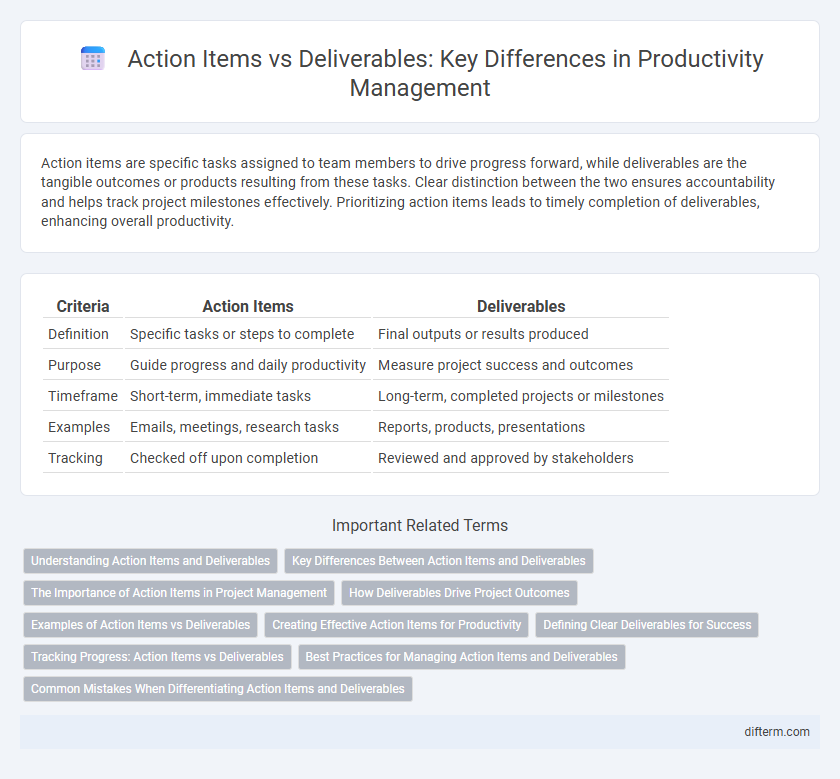Action items are specific tasks assigned to team members to drive progress forward, while deliverables are the tangible outcomes or products resulting from these tasks. Clear distinction between the two ensures accountability and helps track project milestones effectively. Prioritizing action items leads to timely completion of deliverables, enhancing overall productivity.
Table of Comparison
| Criteria | Action Items | Deliverables |
|---|---|---|
| Definition | Specific tasks or steps to complete | Final outputs or results produced |
| Purpose | Guide progress and daily productivity | Measure project success and outcomes |
| Timeframe | Short-term, immediate tasks | Long-term, completed projects or milestones |
| Examples | Emails, meetings, research tasks | Reports, products, presentations |
| Tracking | Checked off upon completion | Reviewed and approved by stakeholders |
Understanding Action Items and Deliverables
Action items are specific tasks assigned to individuals or teams, designed to drive progress and ensure accountability within a project. Deliverables represent the tangible or measurable outputs produced as a result of completing action items, often aligning with project milestones or objectives. Understanding the distinction between action items and deliverables enhances project management efficiency by clarifying responsibilities and expected outcomes.
Key Differences Between Action Items and Deliverables
Action items are specific tasks assigned to individuals or teams to achieve incremental progress, while deliverables are the tangible outputs or results expected at the completion of a project phase. Action items typically have short-term deadlines and are focused on daily or weekly execution, whereas deliverables represent milestones that fulfill project requirements and stakeholder expectations. Understanding this distinction enhances project management efficiency by ensuring clarity in individual responsibilities and overall goals.
The Importance of Action Items in Project Management
Action items serve as clear, actionable steps that drive progress and ensure accountability within project management. Unlike deliverables, which represent finished outputs, action items break down complex tasks into manageable activities that keep teams aligned and deadlines on track. Prioritizing and tracking action items boosts productivity by facilitating effective communication and timely resolution of project milestones.
How Deliverables Drive Project Outcomes
Deliverables are tangible results that directly influence project outcomes by providing clear milestones and measurable objectives, ensuring stakeholders can track progress effectively. Unlike action items, which represent individual tasks, deliverables encapsulate the completion of critical phases that align with project goals and client expectations. Prioritizing deliverables accelerates decision-making, resource allocation, and quality assurance, ultimately driving successful project completion.
Examples of Action Items vs Deliverables
Action items typically include specific tasks such as drafting a project proposal, scheduling client meetings, or updating a team dashboard, focusing on immediate steps to progress. Deliverables are the tangible outputs like a completed marketing campaign, finalized budget report, or functional software module, representing the end product of work completed. Understanding the distinction between action items and deliverables enhances project management efficiency and clarity.
Creating Effective Action Items for Productivity
Creating effective action items requires clear, specific, and measurable tasks that directly contribute to achieving project goals. Action items should be time-bound and assigned to accountable team members to ensure progress and maintain momentum. Differentiating action items from deliverables helps clarify responsibilities, as action items are the steps taken to produce deliverables, ultimately boosting productivity.
Defining Clear Deliverables for Success
Defining clear deliverables is crucial for measuring project success and ensuring team alignment, as deliverables represent tangible outputs that meet specific criteria. Action items are individual tasks assigned to team members, while deliverables aggregate these tasks into concrete results that drive progress. Precise deliverables improve accountability, streamline workflow, and enhance communication by setting explicit expectations.
Tracking Progress: Action Items vs Deliverables
Tracking progress through action items provides granular visibility into daily tasks, ensuring accountability and timely completion. Deliverables represent tangible outcomes that reflect the successful completion of multiple action items, serving as key milestones in a project timeline. Effective productivity management requires monitoring both action items and deliverables to maintain alignment between ongoing efforts and project goals.
Best Practices for Managing Action Items and Deliverables
Effective management of action items and deliverables requires clear prioritization and regular progress tracking using project management tools like Trello or Asana. Establishing specific deadlines, assigning ownership, and maintaining transparent communication ensures accountability and timely completion. Consistently reviewing and updating action items alongside deliverables aligns team efforts with project goals and enhances overall productivity.
Common Mistakes When Differentiating Action Items and Deliverables
Common mistakes when differentiating action items and deliverables include confusing specific tasks with final outputs, leading to unclear project tracking and accountability. Action items are discrete tasks assigned to individuals, whereas deliverables represent measurable outcomes or products resulting from those tasks. Mislabeling these can cause delays, miscommunication, and reduced team productivity.
Action items vs Deliverables Infographic

 difterm.com
difterm.com